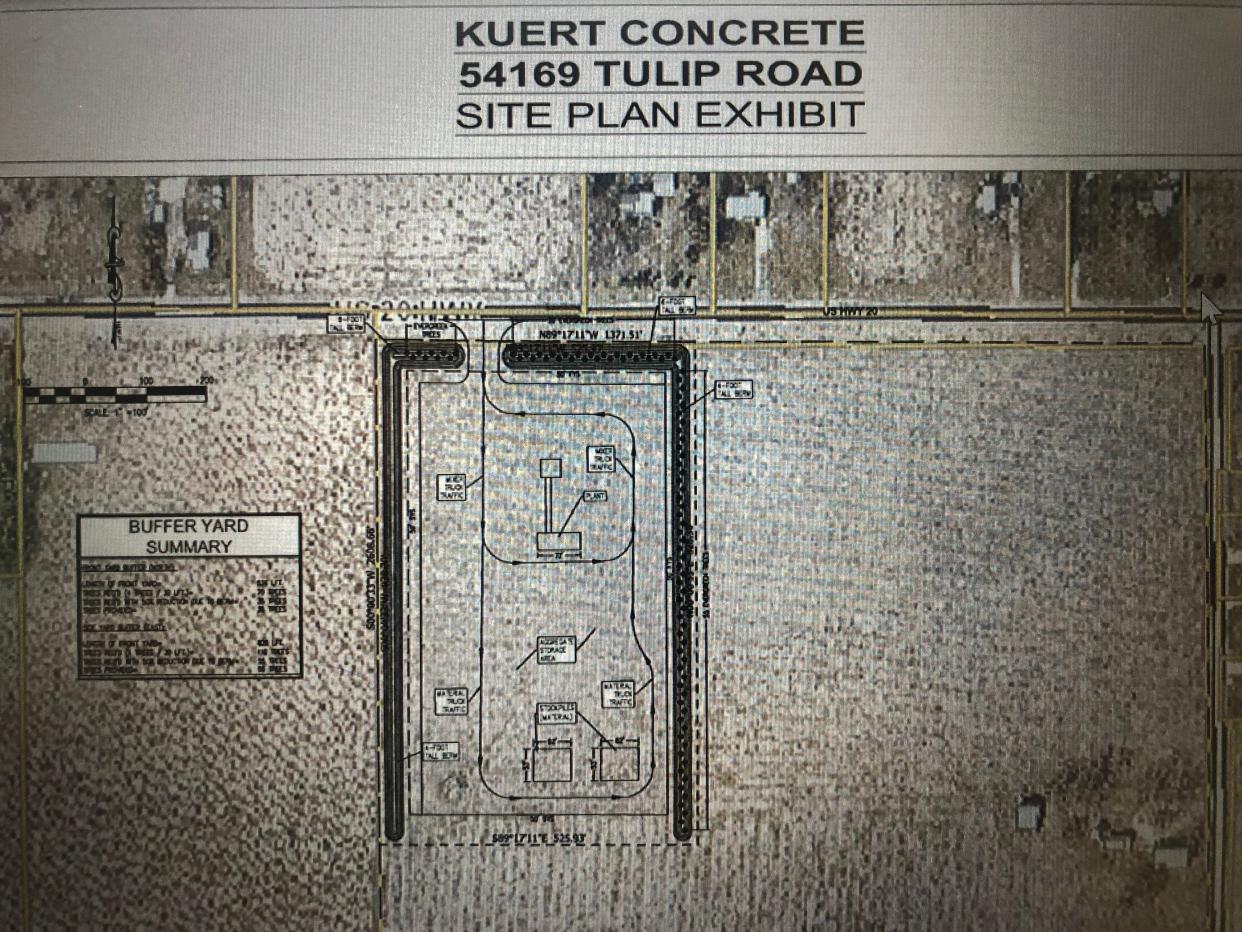Proposed cement plant on U.S. 20 near New Carlisle draws concerns over traffic safety

Kuert Concrete wants to build a temporary concrete plant in a farm field on U.S. 20, just west of Tulip Road, to feed the major industrial development that’s coming near New Carlisle, including the GM-Samsung electric vehicle battery plant.
But neighbors have posed safety concerns about cement trucks slowly pulling out and crossing a speeding lane of traffic on U.S. 20 as the trucks head westward.
“Nobody does 55 out there,” Tim Vanslager, who lives across the road, told the Area Board of Zoning Appeals in February. “I’ve seen multiple accidents out there, too. It’s a disaster waiting to happen.”
Joe Thomas, who represents the area on the St. Joseph County Council, also feels uneasy about the site — and about a special use variance that would allow cement operations on that agriculturally zoned property.
“My problem is traffic on a two-laner,” Thomas said, noting that he’s not against the project but would like other sites to be explored.
That’s why, in the council’s committees meeting on March 26, he proposed sending the special use variance to the full council with an unfavorable recommendation. But his motion didn’t get enough support. So, instead, the Land Use Planning Committee voted to send it with no recommendation to the full council’s meeting at 6 p.m. April 9 in the County-City Building.
The cement plant would use 10 acres of an 88-acre farm field.
Twelve residents of the area had spoken against the use variance at the Area Board of Zoning Appeals meeting on Feb. 14, most of them citing traffic issues but some also worried about cement dust and water issues.
Many of the residents argued it would be better to place the cement plant in or closer to the Indiana Enterprise Center, where construction would happen. Some said county officials should first have a traffic study in hand before making a decision.
The board voted 4-2 to give the variance a favorable recommendation, though with certain provisions, which include: Truck traffic would be limited to state truck routes and certain county roads stipulated by the county engineer. No mining or material extraction would be allowed. After five years, the special use variance would come back to the county for renewal.
Also, Kuert has agreed to build an earthen berm with evergreen trees planted to serve as a buffer on the north, east and west sides of the cement plant.
Jim Sellers, operations manager for Kuert, said the company would be “completely bound” by the restrictions that the Indiana Department of Transportation and its traffic study say.
He said trucks would turn left out of the site onto U.S. 20, then left on Smilax Road and then take Edison and Larrison roads to where they’re going.
He said Kuert currently operates a cement plant with similar challenges at Indiana 15 and U.S. 20 in Elkhart, which was just widened with a deceleration lane for trucks. But one of the key differences there is that it’s by an intersection that has a stoplight. Also at that intersection, Indiana 15 has four lanes, and U.S. 20 has five.
In another example, Sellers said Kuert also has a plant on U.S. 31 in Plymouth where trucks have to pull out into speeding highway traffic, too.
The cement plant near New Carlisle would fill 10 to 11 trucks per hour at the most, Sellers said. Operating hours would typically run from 5 a.m. to 6 or 7 p.m. In rare cases, Sellers said, it would run through the night if there's a major amount of cement to pour, for example, for a recently built power plant.
Dan Caruso of New Carlisle said he isn’t against the cement plant itself, but he thinks it’s in the “absolute wrong place.”
Also citing traffic issues, he said he’s seen trucks turn south onto Smilax as they’re headed for the nearby shredder plant and then wait at the railroad tracks, where, he said, some trains have taken an hour to clear. Caruso suggested it would be better if the cement plant was positioned so that trucks approached construction sites from the south instead.
Vanslager, who’s lived across the site for 34 years, said this is a school bus route. And when the buses stop, other vehicles whiz by and, he said, “I have to watch the bus rock.”
John Borkowski, a longtime resident on U.S. 20, said he’s seen accidents because of vehicles pulling out onto speeding traffic, adding, “There’s going to be fatalities.”
Another resident said he often has to wait 10 minutes to pull out of his driveway onto U.S. 20, on his way to work in South Bend, since traffic has increased in recent years.
Neighbors also worry that cement dust will drift winds across the flat expanse and onto their properties, coat their homes and pose health issues.
Sellers said one way that dust would be controlled is that Kuert would spray a chemical in areas that aren’t paved.
Vanslager worries that, as the cement plant installs a well, that will draw down his groundwater.
Jim Miller, on Tulip Road, noted how the lights from the shredder plant, 1,800 feet behind his home, shine into his windows.
Meranda Herbert, with Irving Materials in Greenfield, Ind., which heads up the Kuert construction group, said the cement plant could avoid that issue by using directional lights. She said they plan to map out the lights’ impact through a “photometrics plan”
Likewise, she said they have equipment to test for noise and how that affects neighbors.
South Bend Tribune reporter Joseph Dits can be reached at 574-235-6158 or jdits@sbtinfo.com.
This article originally appeared on South Bend Tribune: Neighbors concern U.S. 20 traffic safety cement plant by New Carlisle

